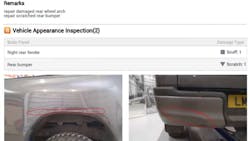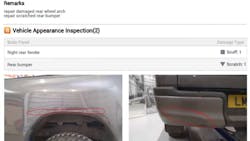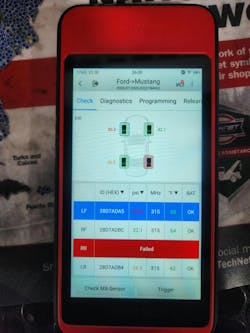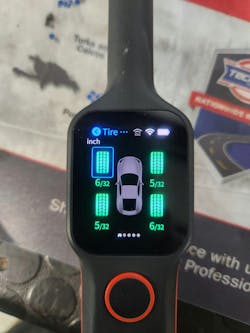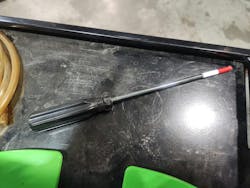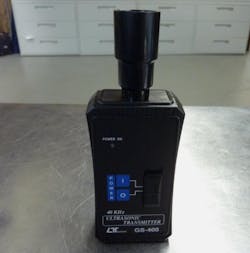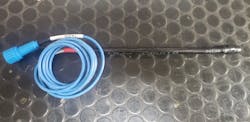Using automotive inspection and leak detection tools to your advantage
Leak detection and inspection tools and equipment have gained a lot of traction in the last couple of years, much like every other category of tools and equipment when it comes to technological advancements. In the shop environment, it’s easy to get lulled into that “This is how we’ve always done it,” mentality. The great thing about today’s technology is that it brings tons of opportunities to increase efficiency and simply do a better job for our clients. When it comes to inspections or leak detection, these opportunities matter more than most people realize. I would like to discuss the hardest type of leak detection we deal with, as well as noise/water leaks, A/C leaks, and some great inspection tips we have in our shop.
Technology-driven tools for vehicle inspection
A small A/C leak can be one of the hardest things to detect. On top of that, many technicians fall into the routine of just checking boxes on inspections rather than actually looking for potential future issues with the vehicle. They check the same items they’ve always checked and often ignore the bigger picture. At our shop, we’ve gone out of our way to integrate more technology-driven tools, far beyond the basic digital vehicle inspection process that, at this point, most successful shops already use. Adding those tools has completely changed how we approach both inspections and leak detection.
AI technology
One of the biggest upgrades we’ve made is the Autel Ultra S2. Its artificial intelligence-driven picture system is impressive. You take a snapshot of the vehicle, and it automatically recognizes scratches, dents, and dings, marking them on the inspection report with their locations. (Figure 1) That saves a huge amount of time compared to manually labeling pictures and often catches damage that might have been missed, like scratched wheels or curb rash. I’ll be the first to admit that I often overlook curb rash, just because it’s so common in my area. Having a tool that flags it automatically makes sure we never miss it.
Cellphones
On top of tools like the Ultra S2, the reality is that every technician today has a cell phone, and almost every shop management system worth anything has the ability to upload videos directly into the inspection report or ticket. Even if a shop doesn’t have a standardized digital vehicle inspection process, videos taken during inspections are incredibly valuable. They show the customer exactly what we’re seeing and add credibility to our recommendations. Processes are what make our shop live and breathe, and the ability to show problems in real time with video makes the process smoother for everyone.
TPMS tools
Beyond basic phones and the Ultra S2, we’ve also added the Autel ITS600. (Figure 2) This tool measures TPMS sensors and then digitally integrates tire pressure data directly into the inspection report on the Ultra S2. When paired with the TBE200 tool (Figure 3), it also measures tire tread depth and even the surface finish of brake rotors and sends it directly to the Ultra S2 report as well. The rotor surface feature is something that’s more popular in Europe as it is required by their MOT inspections but having it available makes the report even more complete. By simply scanning the tire sensors and tread, the data drops right into the report. The process is quick, slick, and consistent, which is what matters most during an inspection.
Pointers
For clarity in photos and videos, we also use simple pointers. It might be something as basic as a screwdriver with a red tip or a dowel pin. (Figure 4) These are small things, but they make it clear to the viewer exactly what part of the photo they should be focusing on. In practice, video tends to beat still photos because it gives context and shows the problem more clearly. Either way, tools and small tricks like these make inspections easier and more effective.
Tools and tips for leak detection
When we move past inspections and start looking at leak detection specifically, that’s where it gets really interesting. The key here is having both old school and new school methods available. Nitrogen is one of the most common tools for detecting leaks, and it still works extremely well. Filling a system with nitrogen and then pairing it with the INFICON Whisper Ultrasonic Leak Detector tool makes detecting small leaks much easier. The Whisper tool can pick up the tiny noises made as nitrogen escapes, and you can even output the data into an oscilloscope. That creates a digital representation of the leak that can be saved, measured, and reviewed later. This allows you to show exactly how much of a leak there was, when it was fixed, and to keep proof instead of just saying, “It was here, now it’s not.”
Tools and tips for leak detection
When we move past inspections and start looking at leak detection specifically, that’s where it gets really interesting. The key here is having both old school and new school methods available. Nitrogen is one of the most common tools for detecting leaks, and it still works extremely well. Filling a system with nitrogen and then pairing it with the INFICON Whisper Ultrasonic Leak Detector tool makes detecting small leaks much easier. The Whisper tool can pick up the tiny noises made as nitrogen escapes, and you can even output the data into an oscilloscope. That creates a digital representation of the leak that can be saved, measured, and reviewed later. This allows you to show exactly how much of a leak there was, when it was fixed, and to keep proof instead of just saying, “It was here, now it’s not.”
Thermal imaging cameras
Thermal imaging cameras can also be used to detect leaks, but the truth is that most leaks that are big enough to show up on thermal imaging are big enough to be found by other methods, like nitrogen or even just soapy water. So, while thermal imaging has its place, it’s not always the most efficient or reliable option.
Using bubbles to spot the leak
Speaking of soapy water, there are products on the market that make using soapy water to create bubbles where a small leak is much more effective. One of them is called Big Blu. It was designed originally for natural gas leaks. Without getting too technical, the product makes soap “thicker” so that it stays in place and reacts to small changes in pressure better than your standard Dawn Dish Soap. In practice, what that means is that the bubbles cling better to surfaces, and they’re much easier to see. When a leak is present, the bubbles stay around longer, making the detection process much easier and more reliable. It’s a simple solution, but one that works surprisingly well.
Ultrasonic leak detection
On the more advanced end, we’ve started using other ultrasonic detection methods similar to the Inficon Whisper tool for some types of leaks. These are especially helpful for water leaks or noise leaks around glass doors and seals. The process involves a 40-kilohertz noise production device, the Lutron GS-400 (Figure 5), which was originally made for detecting natural gas leaks. We pair that with the AES Wave TA329 Ultrasonic Park Sensor Detection Wand. (Figure 6) The wand is tuned specifically to detect 40,000 hertz noises, which just happens to be the exact same frequency that both the noise generator produces and ultrasonic park sensors use. By placing the noise generator inside a vehicle while it produces a 40khz sound and then running the wand around the seals, we can detect any escaping sound that shouldn’t be leaving the cabin. An oscilloscope can pick this up and make it visible, giving us clear evidence of where the leak or noise problem is happening. I’ve got to give props to my friend Hans Jorgensen for showing me this trick.
This process may sound a little fancy, but it’s far more effective than the old-school method of flooding the car with a water hose and trying to guess where the water might drip in. Often, the spot where the water drips is nowhere near the actual leak. And if you’re chasing wind noise, water may never show anything at all, since a wind noise problem doesn’t always let water leak through. The ultrasonic method removes the guesswork and pinpoints exactly where the problem is. It’s cleaner, faster, and more reliable.
Conclusion
What all of this adds up to is that leak detection and inspection tools have taken major steps forward in recent years. The advancements aren’t just in tools designed specifically for the automotive industry. In many cases, we’re finding new ways to adapt tools originally designed for completely different industries. Whether it’s AI-powered inspection systems, ultrasonic noise generators built for natural gas, or enhanced soapy water solutions, the end result is the same: better efficiency, more accuracy, and happier clients.
At the end of the day, we’re not just keeping up with technology; we’re finding ways to use it to our advantage. And if you take anything from this, it’s that the right tools, both old and new, make the job easier, make your inspections better, and make your leak detection more reliable. That’s what makes the investment in these tools worth it, and why they’ll keep playing a bigger role in our shops moving forward.
Tools mentioned
- Autel Ultra S2
- Cellphones
- Autel MaxiTPMS ITS600
- Autel MaxiTPMS TBE200
- INFICON Whisper Ultrasonic Leak Detector
- Oscilloscope
- Thermal Imaging Cameras
- Big Blu
- Lutron GS-400
- AES Wave TA329 Ultrasonic Park Sensor Detection Wand
About the Author
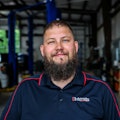
Keith Perkins
Keith Perkins has been in the industry for over 19 years, serving in various capacities, including engine machinist and assembler, dyno tuner, diagnostic technician, instructor, technical information specialist, repair technician, and many more roles through the years.
Currently, Perkins co-owns and operates the L1 Automotive Group with his wife. The L1 Automotive Group is comprised of three companies: L1 Automotive Diagnostics and Programming, Level 1 Automotive, and L1 Automotive Training.
Perkins currently holds the title of ASE Master Certified L1 Technician and ASE certifications A1-A9, L1, L4, X1, P2, xEV Level 2, and various other industry certifications. He also serves as a Subject Matter Expert for the ASE A1, A2, A7, A8, L1, and L4 tests.
Perkins has served on the Board of Directors for NASTF since 2023. He enjoys spending time with his wife of 18 years, Liz, and his two daughters, Rylynn and Bailey, in his off time. His favorite non-automotive activity is skydiving!
